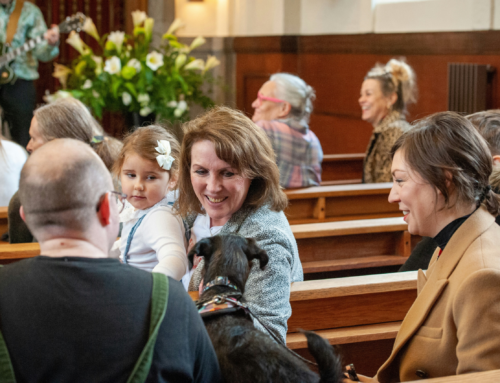Today we hear from Dwayne Milley as he reflects on the Easter story, the names contained within, and what that means about the importance of Valuing People.
This is part of a series on Christian Horizons Core Values: Valuing People, Fostering Belonging, Serving Others, and Respecting Gifts.
Reflection on scripture
Recently I just read Mark 15 and 16 as part of my morning reading time. Have you ever read the Bible and had something odd or new stand out to you that you never noticed before? For me, it was Alexander and Rufus.
First, let me set the stage. These two chapters include the stories of Jesus’ trial, crucifixion, and resurrection. It starts with the chief priests deciding to take Jesus and hand him over to Pilate. Jesus stands silent against the accusations, even as Pilate invites the crowd to consider which prisoner to free – Barabbas, a known murderer, or Jesus. The crowd asked for Barabbas and yelled for Jesus to be crucified.
Pilate had Jesus whipped and sent for crucifixion. The soldiers took him, mocked him, put thorns on his head, hit him, and spit on him. Then they led him out to crucify him. A man named Simon was there from out of town, and the soldiers forced him to carry Jesus’ cross. Here, Mark writes, ‘He was the father of Alexander and Rufus.’
Why did Mark mention Simon’s children? They didn’t seem to be with him. Perhaps it was a way for the reader of the day to know this Simon, or to differentiate him from Simon Peter, the disciple. I kept reading, thinking about these two boys (maybe they were grown, but in my mind, they were children).
Jesus was crucified with thieves, and mid-afternoon he died. Here, Mark notes that among all the people there who were watching, there were Mary from Magdala, Mary the mother of James and Joseph, and Salome. At this point, it seemed to me that Mark was naming certain people in particular.
After this, a man named Joseph from a place called Arimathea, asked Pilate if he could take Jesus’ body. He tended to it, wrapped it in linen, and placed in in a tomb. Mary and Mary watched from a distance.
Mary, Mary, and Salome went up to the tomb the morning after the Sabbath ended. They were greeted by a young man (the angel) who told them that Jesus had come back to life. The angel said, ‘go tell his disciples, and Peter, that he’s going ahead of them to Galilee’.

Reflection on my life
Last week I went to visit Sam – we met 25 years ago, almost half a lifetime for both of us. Sam has a developmental disability; he moved into a support location within Christian Horizons of which I was the manager. We had very different paths of life that led us to meet each other, and then our lives overlapped for a few years. Sam moved on to other support environments and I moved on to a new job. We stayed in touch off and on over the years and have had a few reasons to reconnect since the pandemic.
Last week we went to a local burger joint and ate lunch together (oddly, neither of us had a burger). We chatted about our parents, challenges we’re facing, people we’ve known who have since passed, others who are still with us, and the good times we’ve shared.
Connecting the two
What does my and Sam’s lunch have to do with Jesus’ crucifixion? Nothing really. But what does the mention of Alexander and Rufus have to do with the crucifixion? I’m not sure of that, either.
I wonder. When Jesus’ saw Simon take his cross, did he look at him and see his two boys back home in Cyrene? Did he picture them with their mom, or their auntie? Were they playing at the beach, splashing each other to get relief from the heat, and here’s their dad helping ease the burden for God himself?
When the crowds were watching Jesus from a distance, did he look and see Mary Magdala, a faithful follower, the other Mary, and Salome? Was he encouraged, amidst his pain and imminent death, by the faithfulness he foresaw as they went to tend to his body? Perhaps it gave him some momentary relief to think about the fact that he wouldn’t be dead anymore when they came to his tomb?
And did the angel know how much Peter needed to be told, specifically, that Jesus would be waiting for him in Galilee? Peter had denied knowing Jesus only a couple of days earlier, and now he was being invited, by name, to meet Jesus again.
I don’t know why, for sure, Mark mentioned some of these people by name. Here’s what I do know – Jesus knew their names. And he knew the names of others in the story who are nameless to us. And he knows my name. And Sam’s. And yours.
Jesus showed his love for the whole world – everyone who has ever lived, who are currently living, and who are yet to be born – by dying and rising again. But Jesus knows me. He knows you. He knows ‘the one’. In the story of the lost sheep, Jesus talks about leaving the 99 to go find the one.
People with developmental disabilities, people like Sam, have taught me that each person matters. These days, we often forget about the one, about individual people – we are so distracted by all the things and the many people which call for our attention. But Mark reminds us, and Jesus teaches us, that each person matters, that big stories come to be because of the contributions of people like Simon, Alexander, Rufus, Joseph, Mary, the other Mary, Salome, Peter, Sam, Dwayne, and you.
The one who was crucified, who died, was buried, and who came back to life – he knows our name. And we matter.



